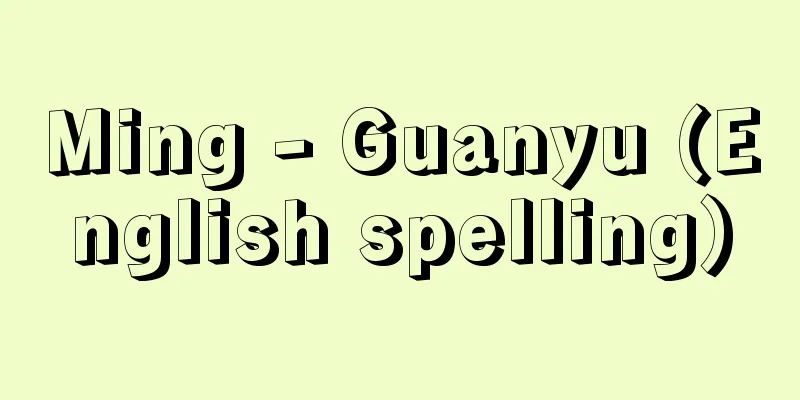Related phrases - Kakarimusubi

|
In literary Japanese, this refers to the conjugated word at the end of a sentence taking the final, attributive, or past tense form in response to the connecting particles "wa," "mo," "zo," "namu," "ya," "ka," and "koso" in the sentence. The connecting particles are called "kari," and the corresponding conjugated word is called "musubi." The process of how this came about is unclear, but in the Nara period, the above form was seen when connecting "koso" with an adjective, and in the Heian period, adjectives that respond to "koso" also took the past tense form. In the Kamakura period, the expression of connecting particles began to become irregular, and in the Muromachi period, it came to be taught as a rule, and thereafter the element of maintaining it as a formality became stronger. It is known that the recognition of linked expressions was already present in the Muromachi period, as there are descriptions of them in secret books of waka poetry such as "Teniha Taigaisho" and "Anekoji Shiki," but it was Motoori Norinaga's "Te Ni Wo Wa Himokagami" that first grasped them in a systematic way. After the expressions became disordered, they became important rules that must be followed in waka, linked verse, and literary prose, and in many cases the tradition is still maintained and taught in modern literary grammar. [Akiho Yamaguchi] ``Nara Dynasty Grammar History'' by Takao Yamada (1913, Hobunkan) ▽ ▽ ``Heian Dynasty Grammar History'' by Takao Yamada (1913, Hobunkan) ▽ ``Kokugoho Ronsho'' by Sutejiro Matsuo (1936, Bungakusha) Source: Shogakukan Encyclopedia Nipponica About Encyclopedia Nipponica Information | Legend |
|
日本語の文語文で、文中の係助詞「は」「も」、「ぞ」「なむ」「や」「か」、「こそ」に呼応して、文末の活用語が、それぞれ終止形、連体形、已然形(いぜんけい)となることをいう。係助詞を「係り」、呼応する活用語を「結び」と称する。発生の過程は未詳であるが、奈良時代には、「こそ」の結びが形容詞の場合以外は、前記の形式がみられ、平安時代には「こそ」と呼応する形容詞も已然形となる。鎌倉時代になると係り結びの表現は乱れ始め、室町時代になると法則として教えられるようになり、以後は形式的に保たれるという要素が強くなる。係り結び表現の認識は、『手爾葉大概抄(てにはたいがいしょう)』『姉小路式(あねがこうじしき)』などの和歌秘伝書のなかにそれに関する記述のあることから、室町時代にすでにあったことが知られるが、これを体系的に把握したのは、本居宣長(もとおりのりなが)の『てにをは紐鏡(ひもかがみ)』が最初である。表現の乱れた以後、和歌・連歌・文語文などでかならず守るべき重要な規則とされたが、現在の文語文法でも多くの場合その伝統が保たれ、教授される。 [山口明穂] 『山田孝雄著『奈良朝文法史』(1913・宝文館)』▽『山田孝雄著『平安朝文法史』(1913・宝文館)』▽『松尾捨治郎著『国語法論攷』(1936・文学社)』 出典 小学館 日本大百科全書(ニッポニカ)日本大百科全書(ニッポニカ)について 情報 | 凡例 |
Recommend
Medial neurosecretory cell
...From here, the ocellar nerves emerge and numer...
Toshima [village] - Toshima
A village in Kagoshima County, Kagoshima Prefectur...
Inner seat - Inner seat
〘Noun〙① One of the benches set up in the Shogunate...
Gomanyu Exercise - Gomanyu Exercise
A production increase movement was carried out in...
Kim Il
Born: 1912, North Hamgyong Province [Died] March 9...
Kyojiro Hagiwara
Poet. Born in Gunma Prefecture. Graduated from Ma...
Eikanmono - Eikanmono
...His style was dynamic, and he possessed an unp...
Ibayashi
〘 noun 〙 A form of Noh performance. It is mainly t...
Open cluster - Sankaiseidan (English spelling)
A star cluster is a relatively loose collection o...
Sukmān (English spelling) Sukman
...The founder, Artuk, played an active role as a...
ACD - Automatic Call Distributor
Automatic call distribution device. A device that ...
Personality cult
Generally, the worship of political leaders is se...
Yoshiyuki Imai
1878-1951 A politician from the Taisho to early S...
Trichoptera
...A general term for insects in the order Tricho...
Treasure Island
An information magazine published by Takarajimasha...









